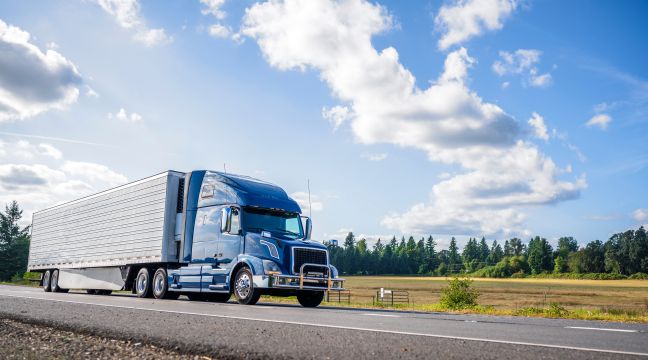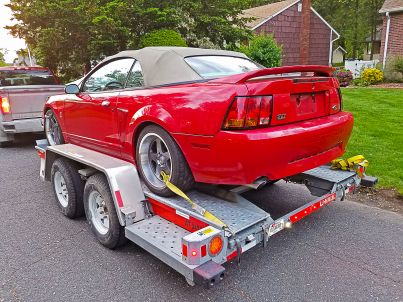It’s possible for a semi-truck to tow a trailer that is 53 inches long. Selecting the right size semi trailer to carry your cargo will help you manage the cost of shipping your goods. When you know the dimensions of a 53′ trailer you can reduce your shipping costs.
Connect with a verified mechanic in minutes. No appointments. No high fees. No waiting. Get back on the road and enjoy the ride.
It is easy to determine the dimensions and weight capacity of a semi by contacting the trailer provider. Different truck trailer manufacturers have different specifications and regulations which affect the size and weight of the trailers. It can be helpful to have a good idea of the dimensions of a semi truck in order to get a general idea of how big the trailer is. That is what we’re here to help you with!
What are the Dimensions of a 53ft Trailer?
Semi-trailers are available in various lengths that range from 28 to 53 feet long high cube and dry vans, but they have a standard width of a 53 foot trailer.
53 foot semi trailer lengths can vary slightly depending on the type of trailer that you are buying and the brand of the trailer. The size of the trailer’s interiors may vary from model to model, as well. When the trailer is fully loaded, it will be about 48 inches long, 99 inches wide, and a little under 110 inches high.
The door opening on the back of a semi-trailer is 94 inches wide and is 102 inches high. It is generally accepted that 53 ft trailers hold a combined capacity of 3,489 cubic feet and weigh 13,500 lbs.
It is very important to have a semi trailer that is appropriately long, principally because there are state and DOT laws that dictate what length is acceptable.
Connect with a verified mechanic in minutes. No appointments. No high fees. No waiting. Get back on the road and enjoy the ride.
There’s various maximum lengths for semi trailers that differ from one county to another, and there are some cases where the trailer’s length can prevent it from fitting into some roads (or simply not being allowed to pass them).
Trailer width and height of semi-trailers are similar to each other, and that is the reason why there is no need for any specific measurements.
There is usually a difference in the length of the semi trailer between one brand of trailer and another. For instance, some companies may offer their own brand of semi trailer to the public, and others may offer their own brand of semi trailer. Therefore, it is good to check in with your specific brand about the dimensions of your own 53ft trailer.

What are the Types of Trailers?
There are various types of trailers used in many different industries, and thus each type of trailer has its own specs and limits. Even then, one dry van from another may be different just because they were manufactured by different brands. So, here are some of the common trailers:
Dry Vans
It is legally allowed to haul 53′ trailers with a weight of anywhere between 42,000 to 45,000 pounds in weight, though it also depends on the size of the cargo van. If the van has three axles, it can haul up to 63,000 pounds of cargo.
Flatbed Trailers
Flatbed trailers can carry loads up to 48,000 pounds, while tri-axle trailers can carry loads up to 65,000 pounds. This makes them a great choice for carrying heavy loads.
Stepdeck Trailers
Standard step deck trailers can haul a maximum of 48,000 pounds of cargo, but tri-axle trailers can carry a maximum of 65,000 pounds of cargo.
Lowboy Trailers
Standard lowboy trailers with two axles can carry 40,000 pounds of cargo. Some users add extra wheels that allow them to carry more weight–up to 95,000 pounds, in fact! This is because the extra axles on a semitrailer enable the user to haul more.
Refrigerated Trailers
Refrigerated trailers are used to transport things that are sensitive to temperature such as milk and other dairy products and farm produce. Freight weight limitations for semi trailers range from 42,000 to 45,000 pounds for the standard trailers, and 63,000 pounds for the tri-axles.

Review engine, brake issues, error codes and more with a Mechanic Online in just minutes.
Ask a Mechanic Live NowHow Do You Know the Limit of Your Trailer Tow?
Semi-trailers are named based on the size, their type of use, and their length. It is common for semi-trailers and tractor-trailers to be interchangeable. Depending on the state, you’ll be allowed for different lengths of semi trailers. This means that there are many different combinations of semi trailers and cab combinations that people can use.
Trailers are allowed to carry a maximum of 102 inches even though most big rigs are allowed to carry much more. Some states allow trailers to be widened to more than 102 inches.
When extra features are added such as winches, mirrors, and lights, it could bring the rig to a maximum of 110 inches. Laws state that a trailer can carry up to 20,000 pounds to be allowed on highways, but make sure to compare the state and interstate laws. However, this limit may be different on bridges or roads that are very unstable.
It will also differ based on the limit that a bridge can support. Trailers with single axes, for example, can carry as much as 20,000 lbs and nothing more. This is a very low limit and it is only possible when the vehicles are very heavy. Special rules allow for other vehicles to be able to carry an extra 10 percent of their weight, except for those with previously mentioned single axles, or a tandem axle and trailers that drive on interstate highways.
Furthermore, there is a limit of 90,000 lbs per year for trailers with a minimum of 51 feet of wheels. But these trailers are prohibited from roads or bridges that are likely to collapse under the weight of the trailers.
How to Make Sure Your Trailer is Safe
It is important to make sure you’re following the rules and regulations of trailer tows and trailer weights. Not only will this avoid you from breaking the laws, but it will also ensure the safety of you and the other drivers on the road.
It is recommended that the semi-truck trailer be attached securely to the truck. This is so that when vehicles are hauling a trailer, they don’t start swerving along the roads. If you want to attach a trailer to a truck, it shouldn’t be longer than 60 feet; that is, if you’re driving it in North Carolina.
Trailers should be 48 feet long, and the width should be 102 inches with the mirror or under 100 inches without it as well as any other accessories or tools.
Trailer hitches are necessary to attach a trailer to a moving truck. A chain with a safety catch is necessary to hold the semi-truck securely in place. It is mandatory for all trailers that are used to transport a semi-truck, unless the trailer is attached to the truck using a fifth wheel.
Max Anthony
Max is a gizmo-savvy guy, who has a tendency to get pulled into the nitty gritty details of technology and cars. He attended UT Austin, where he studied Information Science. He’s married and has three kids, one dog and a GMC truck and a Porsche 911. With a large family, he still finds time to share tips and tricks on cars, trucks and more.
Review engine, brake issues, error codes and more with a Mechanic Online in just minutes.
Ask a Mechanic Live Now




